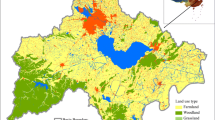Abstract
According to the ecosystem assessment framework developed by the Millennium Ecosystem Assessment (MA), this paper designs an evaluation system of ecosystem services in Poyang Lake area. On the basis of relevant variables disaggregated to 1 km grid using the gridded 1 km, this paper employs factor analysis to extract a number of factors which characterize the ecosystem services of Poyang Lake area. The extracted principal component are then represented onto 1 km×1 km grids by spatial clustering analysis to recognize and identify the minimal but consistent mapping units for ecosystem services which can be used to delimit the boundaries of ecological service zones. The research identifies ten ecosystem service zones in Poyang Lake area according to the consistent principle of core ecosystem service unit. Four kinds of core ecosystem services including supporting function, provisioning function, regulating function and cultural function are identified and represented. The research results could provide both spatially and temporally valuable decision-making information for sustainable ecosystem management in the targeted area.
Similar content being viewed by others
References
Daily G C (1997). Nature’s Service: Social Dependence on Nature Ecosystem. Island: Island Press
Deng X Z, Liu J Y, Zhan J Y, Zhao T (2004). Dynamic simulation on the spatio-temporal patterns of land use change in Taibus County. Geographical Research, 23(2):147–156 (in Chinese)
Fu B J, Chen L D, Ma K M (1999). The effect of land use change on the Basinal environment in the Yangjuangou catchment in the Loess Plateau. Acta Geograph Icasinica, 54(3): 241–246 (in Chinese)
Huang X W, Chen B M (1999). The theory and application about the Basinalization of Chinese ecological assets. Acta Ecologica, 19 (5):602–606 (in Chinese)
Liu D L, Liu X Z (2006). Application of principal component analysis to the comprehensive evaluation of water quality in river. Research of Soil and Water Conservation, 13(3): 124–128 (in Chinese)
Liu J Y, Buheaosier (2000). Study on spatial-temporal feature of modern Land-use change in China: using remote sensing techniques. Quaternary Sciences, 20(3): 229–239 (in Chinese)
Liu J Y, Zhan J Y, Deng X Z (2005). The spatio-temporal patterns and driving forces of urban land expansion in China during the economic reform era. Ambio: A Journal of the Human Environment, 34(6): 450–455
Ma Y L, Ma Y Q (2004). Breif introduction of existing problems and countermeasures for sustainable land resources use in the Poyang Lake Region. Research of Soil and Water Conservation, 4: 7–8 (in Chinese)
Ma Y L, Mei L H (2003). Loss of water and erosion of soil in the Poyang Lake Region and its prevention and cure measure. Journal of Geological Hazards and Environment Preservation, 14(3): 31–35 (in Chinese)
Millennium Ecosystem Assessment (2005). Ecosystems and Human Well-being: Current State and Trends, Volume 1. Washing DC: Island Press
Wang X H, Fan Z W, Cui L J, Yan B Y, Tan H R (2005). The wetland ecosystem evaluation in Poyang Lake. Beijing: Science Press (in Chinese)
Wang X H, Lu J J (2005). An approach on ecosystem services classification and valuation. Chinese Journal of Ecology, 24(11): 1314–1316 (in Chinese)
Yang S L, Li Y S, Hu X X, Pan R Y (2006). Optimization Study on k Value of K-means Algorithm. Systems Engineering-Theory & Practice, 22(2): 101–105 (in Chinese)
Zhan J Y, Deng X Z, Yue T X (2004). Landscape change detection in Yulin prefecture. Journal of Geographical Sciences, 14(1): 47–5
Zhan J Y, Deng X Z, Zhao T (2006). Scenarios analysis on the landscape change in Qingyang prefecture based on system dynamic model. Geography and Geo-Information Science, 22(3): 101–105 (in Chinese)
Zhang H F, Ouyang Z Y (2007). Spatial scale characteristics of ecosystem services. Chinese Journal of Ecology, 26(9): 1432–1437 (in Chinese)
Zhao S D (2001). Millennium ecosystem assessment: background, objectives and suggestions for its implementation in China. Quaternary Sciences, 21(4): 330–336 (in Chinese)
Author information
Authors and Affiliations
Corresponding author
Rights and permissions
About this article
Cite this article
Shi, N., Zhan, J., Wu, F. et al. Identification of the core ecosystem services and their spatial heterogeneity in Poyang Lake area. Front. Earth Sci. China 3, 214–220 (2009). https://doi.org/10.1007/s11707-009-0008-6
Received:
Accepted:
Published:
Issue Date:
DOI: https://doi.org/10.1007/s11707-009-0008-6




